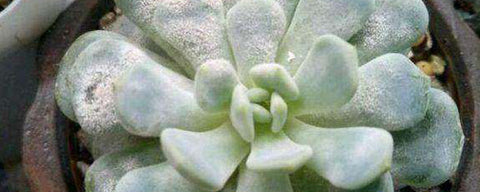Fungus Problem?
Have you looked at your succulent or house plants and noticed some black/white spots on them? Diseases and pests will develop when plants are overwatered, or underwater, along with the lack of air flow. When they are highly stressed, they are unable to protect themselves allowing for disease to develop. There are many different types of fungus that can attack your plants' foliage, causing damage or sometimes killing the plant if left untreated. The most common fungal issues that I find many plant collectors and hobbyists often deal with are black fungus and powdery mildew. It can often be frustrating and heart breaking to have your favourite plant(s)/succulent(s) infected and eventually die. Let’s dive deeper on the causes and some remedies to treat them.
What is fungus? And what are the causes?
Black fungus is also known as Sooty Mold. They often look like black patches on the base of the surface of the soil. It can be difficult to spot. In most cases, black fungus is secondary to an infestation from other pests. The presence of black fungus is a sign that your houseplant is infected with either scales, whitefly, mealy bugs and/or aphid damage. When these pest feeds on the plants, they excrete a residue called “honeydew”. If the black fungus is left untreated, it will inhibit photosynthesis, which will cause farther damage.
Powdery mildew is pretty easy to identify. It is a white or grey powdery film on a plant’s leaves and/or stem. This particular fungus thrives in warm, humid environments and overwinters in the soil. It is important that the substrate is well drained to ensure the soil does not stay wet for too long or when water does not stay on the leaves for a long period of time. Powdery mildew will start off as white spots on leaves or stems. As the infection spreads, the spots with turn yellow-burn and eventually black. As the plant continues to grow its leaves, they will be distorted and eventually wilt and die off.
Here are some remedies
Black Fungus
In the early stages of infection, spray the leaves with horticultural and neem oil. Before use, it is recommended to test on a small leaf before spraying on a whole plant. To use, add 1-2 tbsp of neem oil and 1 tsp dish soap to a gallon of water; spray on both side of the foliage. Reapply after 7-14 days. I have not used either of these methods, but have heard great things about neem oil. After treatment, keep plants out of direct sunlight.
I treat my plants naturally by wiping the leaves to remove any pests that may not be visible to the eyes. Check the roots as pests, especially mealy bugs, can be hiding in the roots and/or in the substrate. Spray a cotton swap or q-tip with 70% alcohol solution and wipe down the infected area. If the plant is heavily infected, spray the whole plant with the alcohol solution making sure to hit the top and bottom of the foliage and in between rosettes as some can be hiding between them. For the ones that are infected, I would remove the leaves and put them outside in a shaded spot and/or in and areas that has good air flow (fresh air) and allow it to recover. Plants that are healthy will bounce back given some time and those that are weak will struggle no matter what you do. (Dawrin’s Theory of Evolution - Survival of the fittest). Sometimes the best thing to do is getting rid of the plant so it doesn't spread to other plants.

.

(E. Torres) ( E. Fire Pillar) - left outside
Powdery Mildew
I have been fortunate enough not to have had powdery mildew on any of my plants so these recommendations are from doing my own research. The main cause of powdery mildew is from poor air circulation and/or stagnated air. Therefore, the simplest solution, is to allow for “new” air to circulate by opening a window and using a fan. Powdery mildew thrive in low temperatures (10-16C) and high humidity. Make sure to isolate the infected plants in order to prevent it from spreading. Here are different methods that you can use:
- Milk - there is no scientific explanation to why milk helps to treat powdery mildew, but it is believed that when milk interacts with the sun, it produces free radicals that are toxic to fungus. Using a 60:40 milk-to-water mixture, spray the infected plants bi-weekly.
- Banking Soda - this is used as more of a preventative method. Baking soda creates an alkaline environment which will kill fungus. This will raise the pH level to 9, which is very high (refer to our benefit of rainwater on pH level).
- mix 1 tbsp of baking soda with 1/2 tbsp of hand soap in 1 gallon of water
- spray affected leaves with the resulting mixture. **do not apply during daylight hours
- Sulphur - very effective at preventing and controlling powdery mildew. Follow the instruction on the bottle. Sulphur can be purchased as a dust or liquid.
- Neem oil - very effective in treating powdery mildew by disrupting the plant's metabolism and stopping spore production. Neem oil can be used as a preventative measure as well.
- mix 3 tbsp of Neem oil in 1 gallon of water
- apply to infected plants every 7-14 days
With all of these methods, make sure to test on a small leaf before spraying the whole plant as some can cause burns or damage to plant, especially new growth.
I hope this was helpful and we would love to hear about your experience and methods. Are there other remedies you’ve heard of that we did not mention?

 .
. 
